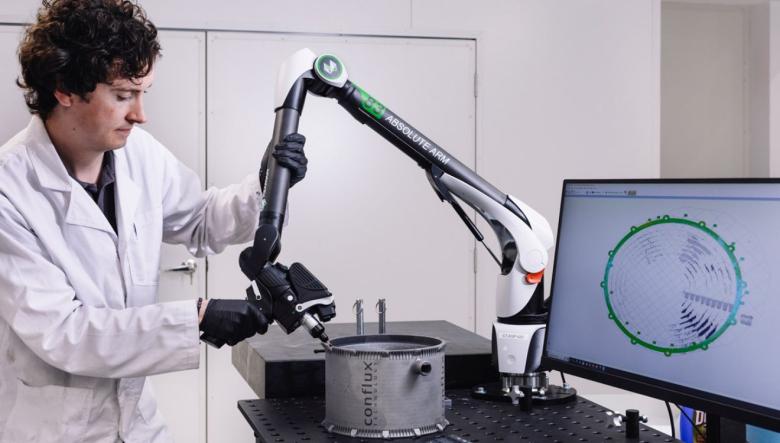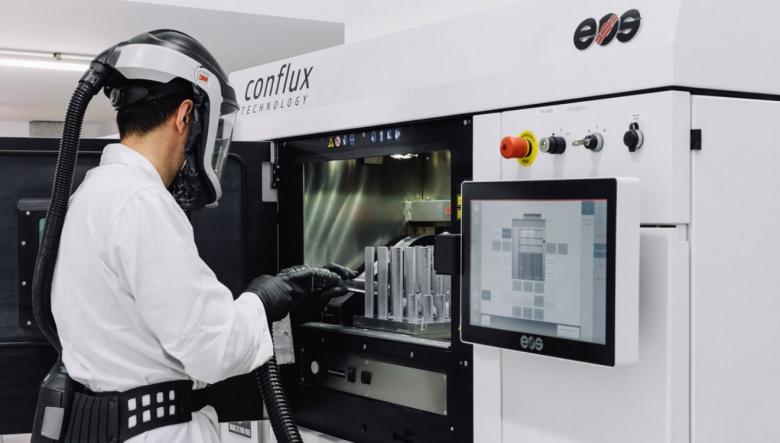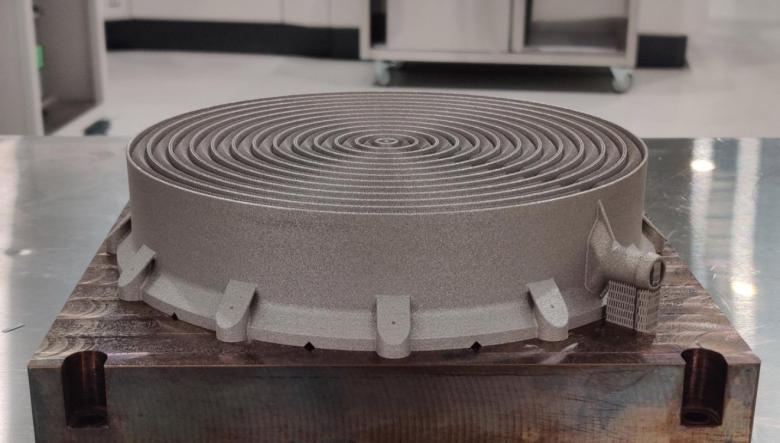Close up view of a Conflux 3D printed heat exchanger. Image courtesy of Conflux Technology.
The most iconic part of a space mission is arguably its launch. The fiery spectacle of a rocket blasting off is a sight most humans recognise. However, while the intense heat gives us an exciting show, it also creates a major technical challenge.
The flames that erupt below a rocket engine are the result of gases being ejected from the combustion chamber at very high temperatures. The exhaust plume from the RS-25 engines on NASA’s Artemis-era Space Launch System can exceed 3000 degrees Celsius.
Rocket engineers therefore have the important job of managing the risks these extreme temperatures pose to the launch vehicle’s structure, components, payload and occupants.
One way to keep the temperature under control is with a cooling system inside the engine. Geelong-based Conflux Technology, a leading supplier of heat exchangers for multiple industries on Earth, is now bringing its expertise to the space industry.
Thermal trade-off
Heat exchangers are devices that take heat out of one fluid (either a liquid or a gas) and transfer it into another. They’re found just about anywhere something mechanical needs cooling or heating – whether that’s a bar fridge or a jet aeroplane.
While the technology itself is conventional, Conflux’s approach to making it is not. The company uses additive manufacturing (also known as 3D printing) to design and build heat exchangers in unique shapes and sizes. This approach unlocks almost limitless possibilities to customise a solution that fits a specific environment.
Conflux founder and CEO Michael Fuller says this puts the company in an ideal position to tackle the extreme thermal challenges presented by rocket engines and other space systems.
‘Space applications see large changes in relative temperatures, densities, and viscosities of the working fluids throughout the heat exchangers,’ Mr Fuller says.
‘With additive manufacturing, we’re able to adapt our 3D surface geometry designs throughout our heat exchangers to optimise for the changing thermal-physical properties of the fluids.’
Conflux is now using this approach to create a heat exchanger that will sit inside the gas duct of a rocket engine, with support from the Australian Space Agency’s Moon to Mars Initiative.

Performing quality checks on a 3D printed heat exchanger, with a virtual 3D model. Image courtesy of Conflux Technology.
An international partnership
To help develop the technology in practice, Conflux has struck a partnership with German company Rocket Factory Augsburg (RFA).
Mr Fuller says the two companies came together thanks to a shared interest in additive manufacturing.
‘RFA’s mission to use modern serial production strategies includes leveraging additive manufacturing to achieve cost-effective production, which naturally led to our partnership,’ Mr Fuller says.
‘By working with Conflux and respective experts in the additive manufacturing field, RFA is able to realise the benefits of additive manufacturing – from reduced development lead times through to flexible digital-inventory based production.’
Conflux expects to deliver the launch-ready heat exchanger to RFA in early 2024.

3D printing prototype features for a heat exchanger. Image courtesy of Conflux Technology.
Creating opportunities in space and on Earth
While the heat exchanger is pushing technical boundaries, it’s also ground-breaking for Conflux itself. The company sees the project as a gateway to further refine and adapt its technology for other areas of the space industry.
‘There is a myriad of heat exchangers applied across all space hardware sub-systems, and all of them have opportunities for improvement,’ Mr Fuller says.
‘We’re testing new materials including Monel K500 – a high-strength, corrosion-resistant nickel-copper alloy that makes it suitable for high-stress conditions such as space.
‘Its thermal stability means it’s not affected by the extreme fluctuations in temperatures that other materials succumb to.’
Mr Fuller also believes making inroads in the space market will help advertise the capability of Conflux’s technology to other sectors on Earth.
‘The emphasis on reliability and performance in the extreme conditions of space reinforces our commitment to producing heat exchangers that excel in any challenging environment… whether in aerospace, motorsports, industrial processes, or other sectors,’ Mr Fuller says.
‘Successful deployments in space missions will inherently reduce the apprehensions associated with adopting new technologies on Earth.’
With technology manufacturers always looking to make more sustainable products by reducing heat stress, a space-proven solution from the heart of a rocket engine will be hard to ignore.

Test printed heat exchanger with Monel K500 material. Image courtesy of Conflux Technology.
